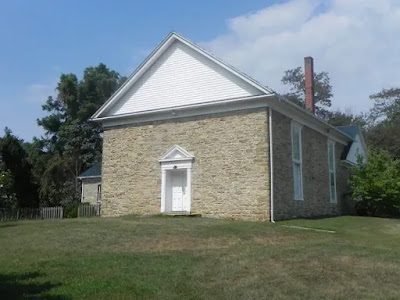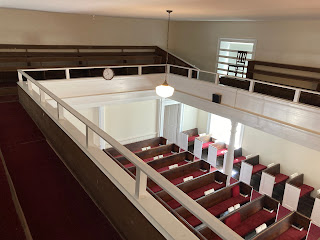Here is an historical gem contributed by Cousin Kevin Pearson; a newspaper clipping he found in his grandmother's papers. This clipping is from the front page (right column) of the Fauquier Democrat of 19 November 1921. It describes the tragic shooting of Robert Joseph Lunceford. Robert is in Baldwin Lunsford's Judith Creel line. You can click on his name to get his family tree entry.
Let's start with a transcription of the clipping.
Many Rumors As To Fatal Shooting
How Robert Lunceford of Dudie, VA Met Death Is Mystery at Winchester – No Official Probe Begun
Winchester, VA., Nov., 13 – After lying in a morgue here 32 hours unclaimed, the body of Robert Lunceford, 27 years old, of Dudie, Fauquier county, alleged to have been shot by the Sheriff or one of his deputies in a pistol battle near Washington, Rappahannock county, late last Thursday night, was last evening taken in a motor truck to his home.
L. H. Royston, funeral director, of Marshall, VA. who came for the body, said it was the intention to hold the funeral some time today. He did not know whether an inquest would be held. He said he had not heard of any steps being taken to conduct an official investigation of the exact manner in which Lunceford came to his death.
Brother In Ignorance
Ernest Lunceford, a brother of the dead man, said he knew nothing whatever about the shooting, as he was in Fauquier county at the time, and all he knew was that word came to the home place that his brother had been shot and fatally wounded. The funeral director said he had been told the body would be interred in the family graveyard near Marshall.
When the body of Lunceford was removed from Memorial Hospital on Friday morning to a morgue the undertaker was directed not to prepare it for burial and to leave the corpse just as it was until an officer came from Rappahannock county, in which the shooting occurred, to make an inspection of the wound. The orders were complied with, but no officer put in an appearance. Instead the undertaker and a brother of the dead man came last evening and took the body home.
Many Rumors Afloat
Word came from Rappahannock county that many conflicting rumors were afloat as to the how Lunceford met death. Officers of that county reiterated their original version to the effect that Sheriff Hubert F. Keyser, armed with a warrant, and his deputies had gone from Washington, the county seat, into the country several miles to intercept a car alleged to contain contraband liquor, and that when commanded to halt the driver of the car stepped on the gas. As the car sped away a shot is said to have been fired at the Sheriff’s party. The later is understood to have returned the fire, and in a short time a pitched battle was in progress along the lonely mountain road.
Another report said the shooting was not done from automobiles, but that the men were on the ground at the time. The wound that resulted in Lunceford’s death shows that the bullet entered low in the back, shattering his liver.
Doctors and hospital nurses who attended the wounded man here positively refused to make any statement concerning the case, and would neither confirm or deny inquiries as to whether he made a statement before dying. Rappahannock county officers were anxious to learn whether any such statement had been made.
Resentment Reported
Information reached here today from Rappahannock and Fauquier counties indicating a feeling of resentment, at least among friends of the dead man, although there was nothing to indicate a disposition to take violent measures. It was stated however, by one that the shooting was “a brutal affair”.
Asked what the people thought of it, the man said he did not think they had yet fully realized the gravity of the situation. He added that Lunceford’s people stood very well among their friends and neighbors, and that much sympathy had been expressed by acquaintances who had heard of the tragedy.
Lunceford was married. He was exempted from military service during the World War because of dependents. His wife was formerly Miss Annie Creel. They have three children. His father, Frank Lunceford, his mother and five brothers, Walter, Charles, Ernest, Wilbur and Clarence, and three sisters, Mrs. Margaret Mc Cormick and Misses Lucy and Ella Lunceford, survive.
Rappahannock county officers are endeavoring to locate three men named Smith, one colored, alleged to have been with Robert Lunceford, of Dudie, VA., charged with bootlegging, when the later was mortally wounded last week in a gun battle with Sheriff Hubert Keyser and deputies near Washington, Rappahannock county.
What a fascinating but tragic story of a young father finding himself on the wrong side of the law running some Fauquier shine so it seems.
A few questions remain; where did the actual gun battle take place, and why did he wind up in the Winchester hospital? Did the pursuit go all the way over the Shenandoah ridge line? The article claims that the burial was handled by Royston's but the undertaker on the death certificate is listed as George Kurtz of Winchester. I also have not been able to find an entry for his grave on Find-A-Grave. Definitely not in the main Marshall cemetery unless it is unmarked. Is there another Lunceford cemetery in the Marshall area?
 |
| Robert's death certificate (click for larger image) |
 |
| WWI draft registration (click for larger image) |






























